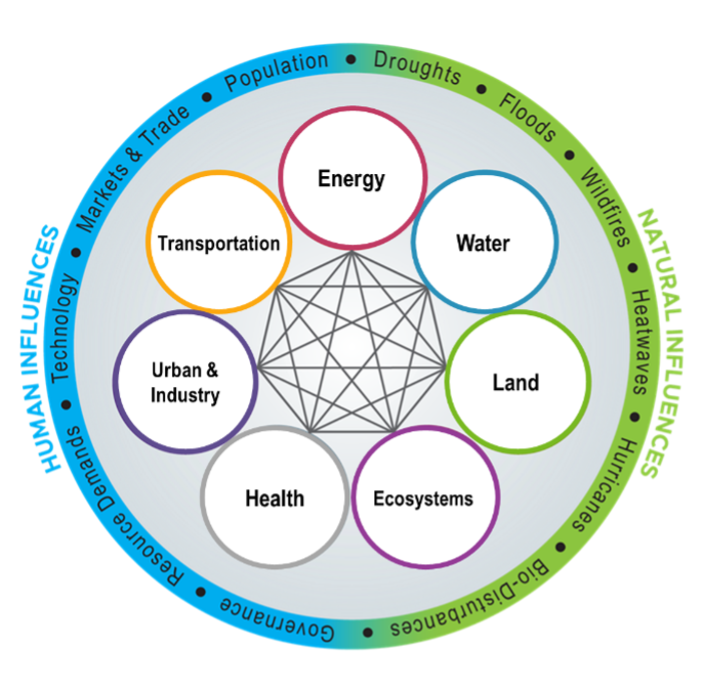About MultiSector Dynamics
MultiSector Dynamics (MSD) advances the science of complex interactions and co-evolutionary pathways among human and natural systems, sectors, and processes. The research is focused on the energy system, including resource availability and recovery, the grid and multiple energy sources, demands, supply chains, and the critical interdependencies among major sectors and infrastructures, including water, land (e.g., agriculture), transportation, and more.

MSD develops and draws from capabilities including physical and natural systems models; artificial intelligence- (AI) driven workflows, model integration, and pattern analysis; and a range of economic, risk analysis, and complex decision theory methods. Scales are local to global and minutes to multi-decadal, depending on the science questions, system features, and behaviors. Frequently, there are scale interdependencies that require advanced hierarchical, multiscale approaches, for example, with energy, supply chains, and trade.
MSD provides essential foundations for EESSD’s Dynamical Digital Testbeds, creating virtual replicas of physical regions and landscapes with its hyper-resolution and multiscale focus on strongly interdependent natural-human earth systems. MSD is the primary provider of human (energy and multisector) representations within the EESM Integrated Modeling Framework as well as the Energy Exascale Earth System Model (E3SM).
Program Area Description
The human-earth system—including settlements, infrastructure, natural resources, economics, and interdependent sectors and natural systems—is highly complex and continuously changing. Stressors, constraints, and other factors that affect change take many forms and influence the system at varying spatial and temporal scales, often in unanticipated ways.
Science insights and tools from MultiSector Dynamics offer deep, scientifically based insights that can help inform next-generation U.S. infrastructure, strengthen energy and economic security, and understand the role of new and potentially transformative technologies and their broad implications. Topical and methodological areas of focus in MultiSector Dynamics include:
- Dynamical Digital Testbeds for scientifically complex regions of human and natural systems subject to compounding stressors often at extreme scale and/or subject to rapid change
- Natural resource availability, recovery, use, economics, and trade
- Characteristics and features of infrastructure interdependence and resilience
- Regional to global economic development and its implications for demands across sectors
- Processes, barriers, and solutions for technology expansion, for example in water for thermoelectric cooling, critical mineral demands and substitutions, and data center dependencies on heterogeneous availability of energy, water, and land
- Supply chains, more generally, such as sea ice retreat and the opening of Arctic shipping lanes and trade routes
- Interdependencies among energy, water, land systems, and sectors
- Urban morphologies, population dynamics, land use and land cover change, and evolution in energy-intensive, human-natural formed landscapes
- Characteristics and features of compounding stressors, including extreme events and other natural and human-induced shocks, their effects, and potential integrated system responses
- AI-driven scenario discovery for insight into thresholds and tipping points, along with sensitivity studies and uncertainty characterization
- Data science, analytics, and AI hybrid models
Besides the focus to understand the system dynamics surrounding interdependencies within the natural-human system, MSD seeks to advance scientists' understanding of nonlinearity and instability associated with multiple stressors that can lead to cascading failures in connected sectors and systems. An important characteristic of nonlinearity and system failure is the probabilistic interdependence near thresholds associated with extreme weather, infrastructure designs, and operational demands.
Additionally, and at a more fundamental level, MultiSector Dynamics supports the development of interoperable tools and methods to reveal a basic understanding of different levels of complexity required to analyze interdependency.
